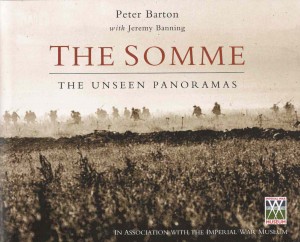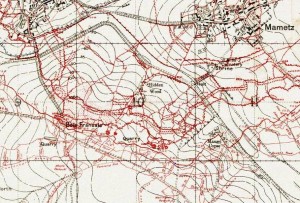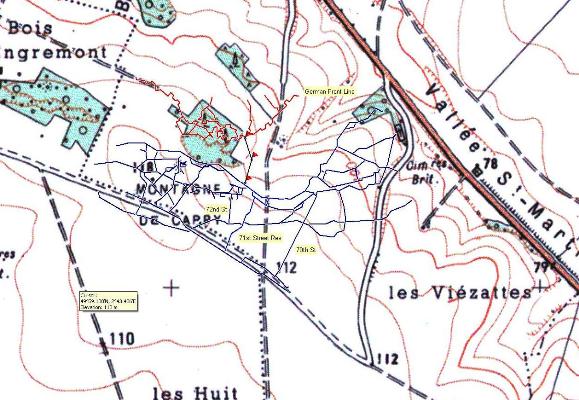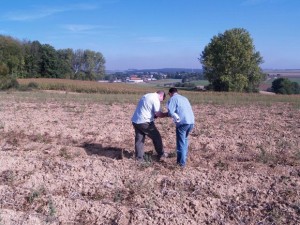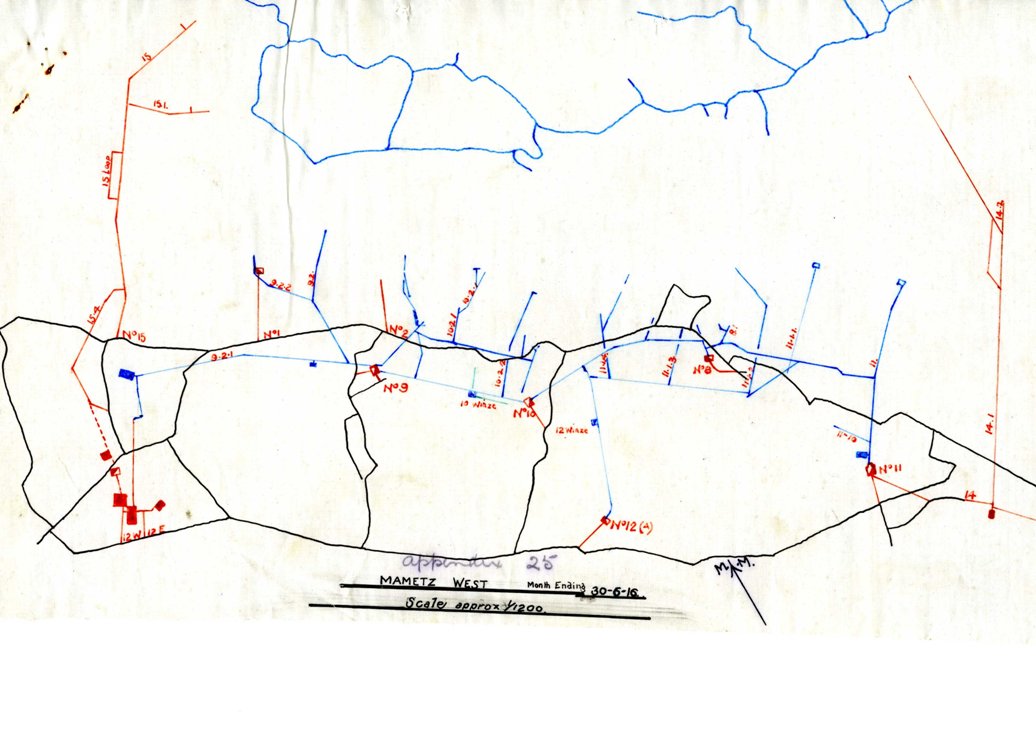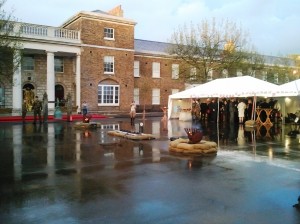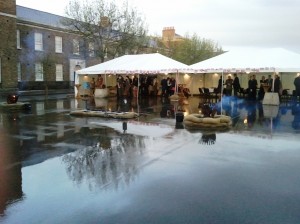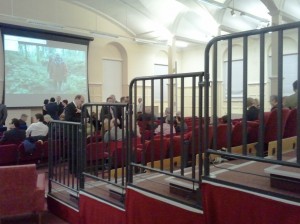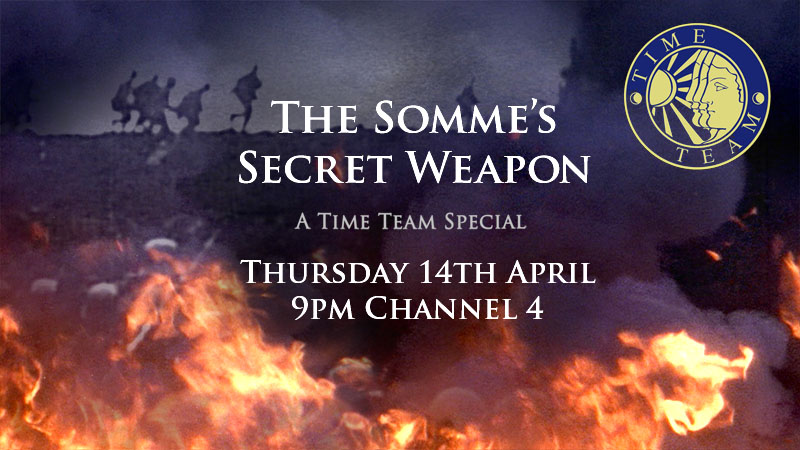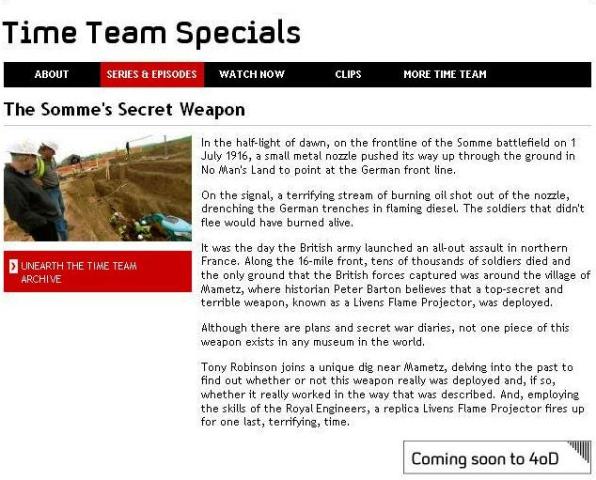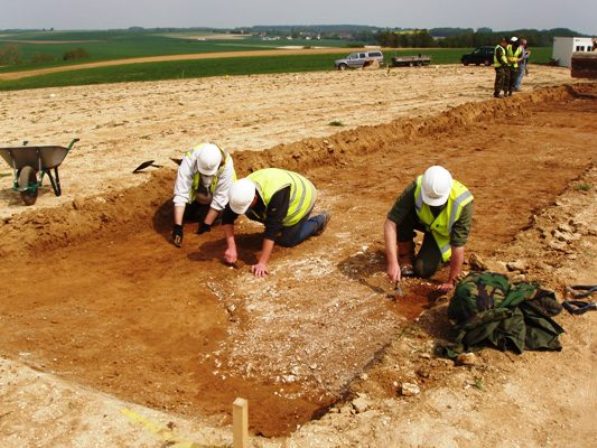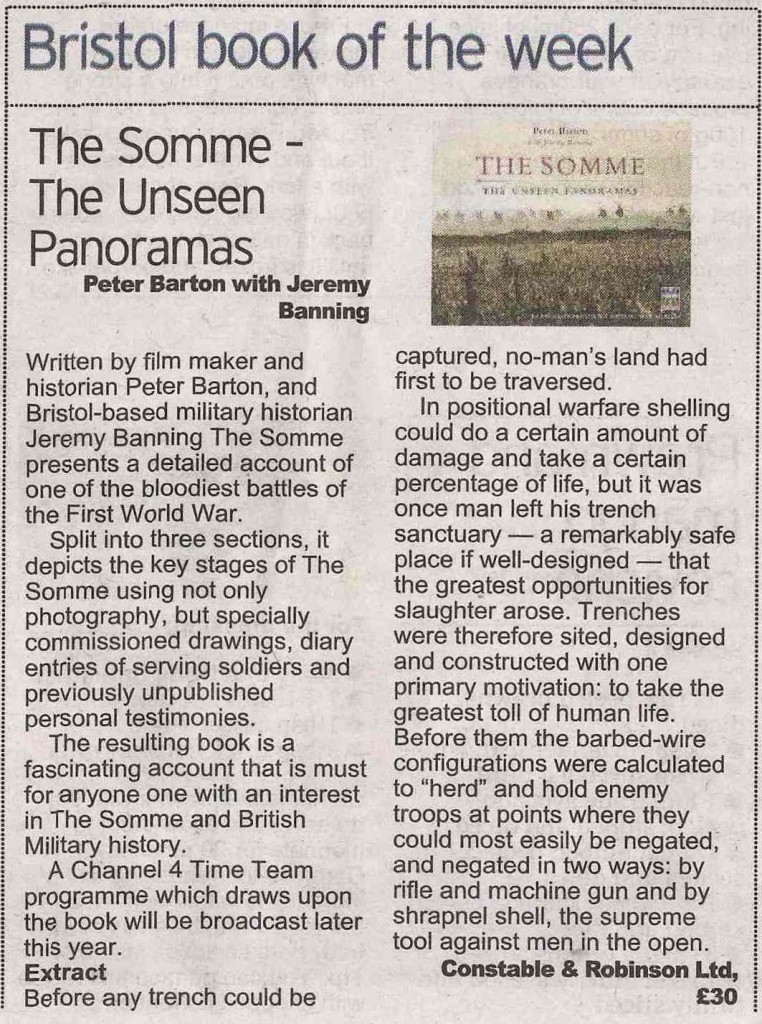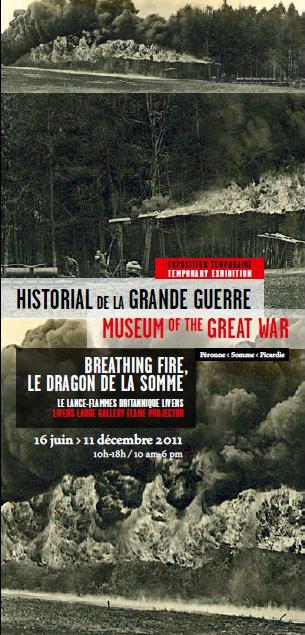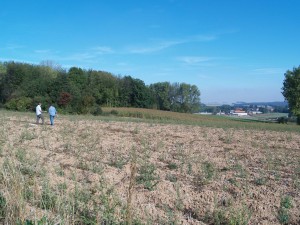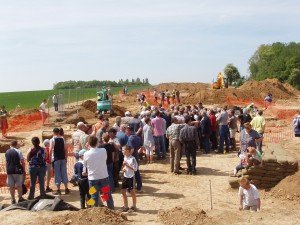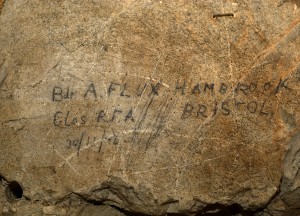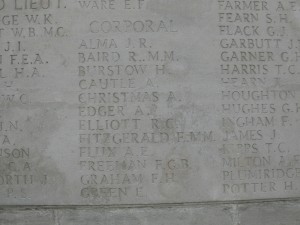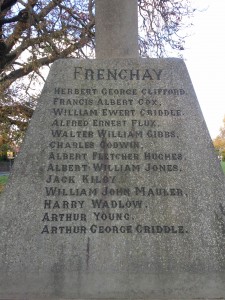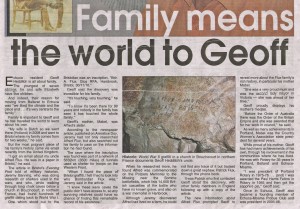Posts Tagged ‘Somme’
Following the three week archaeological dig at Mametz last May I am pleased to report that a new exhibition is to open at the Historial, Peronne from 16 June 2011.
Below is the text from the flyer that has been produced. If you are on the Somme from June – December then please do visit the Historial for the chance to see this exhibition.
An exhibition that tells for the first time the story behind the Livens Large Gallery Flame Projector. Employed only ten times during the war – nine of which were on the Somme. The machine was 19 metres long, 40 centimetres wide, and weighed 2.5 tonnes. It was deployed from a tunnel beneath No Man’s Land by a specially-trained crew of seven, and fired a jet of flaming oil 100 metres long over the German trenches: the strangest, rarest and most horrifying weapon of the Great War.
In May 2010 historians and archaeologists excavated a section of the British trenches near the village of Mametz in search of the remains of a Flame Projector believed to have been buy cheap tramadol 100mg abandoned underground in late June 1916, just before the Battle of the Somme. The results were extraordinary, and for the first time for almost 100 years some of the original parts found in 2010 can be viewed alongside a specially-commissioned replica constructed by local students of vocational training centres.
A special screening of the film “Breathing Fire – Le Dragon de la Somme” will be shown at the opening of the exhibition, 16 June at 6pm.
 A downloadable version of this flyer in pdf is available by clicking on the link below. Please feel free to disemminate this information to all your friends and battlefield visitors. It promises to be a terrific exhibition and for many will be the first chance to see parts of the Livens Flame Projector, buried in the Somme mud for 94 years.
A downloadable version of this flyer in pdf is available by clicking on the link below. Please feel free to disemminate this information to all your friends and battlefield visitors. It promises to be a terrific exhibition and for many will be the first chance to see parts of the Livens Flame Projector, buried in the Somme mud for 94 years.
Breathing Fire – Le Dragon de la Somme exhibition
Exact date of transmission of the version for UK television still to be determined. I will post this when I find out the date from the production company.
I use the tools supplied by WordPress and Google Analytics to follow how visitors reach my site. I am seeing a large number of visitors searching for details on the archaeological dig and accompanying television documentary programme that followed our search for any surviving pieces of a Livens Large Gallery Flame Projector at Mametz in May 2010. As the site was open to visitors and there was no ban on photos I don’t think it is breaking any great secret to reveal that we DID find pieces of this amazing weapon. It was 19 metres long, 40 centimetres wide and weighed 2.5 tonnes. Its specialised team of seven ensured it fired three ten second bursts of flame for up to 100 metres and, perhaps most remarkably, this was fired from a tunnel or ‘Russian Sap’ dug specially under No Man’s Land.
At present (14 February) there is no broadcast date available for the UK or North American market. In the UK the programme will be broadcast as a Channel 4 Time to order tramadol Team Special. As soon as I know the broadcast date I will post the details so please check back or follow me on Twitter to be kept up to date.
In the meantime, a couple of pictures.
Update – 13 April 2011.
The Time Team Special will be shown on Channel 4 at 9pm on 14 April. A detailed description of the birth, evolution and structure of the project along with maps and images is now available here:
It has been reported in the Australian press (Sydney Morning Herald) that the body of an Australian soldier has been found on the Somme battlefield. The piece, entitled ‘Somme gives up the body of another Anzac’ dated 17 January tells of a the remains of a body being disturbed during digging for a drainage ditch near the infamous site of Mouquet Farm (also known as Moo Cow or Mucky Farm).
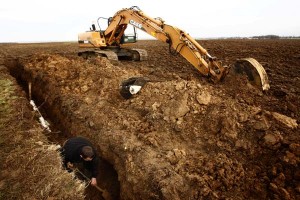
The site near Mouquet Farm where the Australian soldier's remains were found. Published online at http://www.smh.com.au/. Copyright Mike Bowers
The remains were excavated by local café owner Dominique Zanardi who was on site with the Mayor of Pozières. The report mentions that “there was no identity disc on the body, the soldier’s pistol holster is stamped “AUSTRALIA” and “WA””. I know I am not alone in advocating the involvement of qualified archaeologists using a professional approach. The issue of finding bodies on the battlefield has been going on for 90+ years but, following the precedent set by the dig at Fromelles, it is a very backward step to allow amateur excavation of these sites, however well intentioned the persons involved may be. The shocking pictures from the retrieval of fifteen British soldiers at Beauamps-Ligny are clear evidence of the need to employ professionals.
A follow-up piece entitled ‘Army moves to claim lost Digger‘ was published today which elaborates further on the next steps.
I have been researching certain members of this family after I spotted some graffiti of a Great War soldier, Bombardier Alfred Flux from Hambrook, whilst exploring caves under the church in Bouzincourt on the Somme in May last year. Whilst the caves were covered in graffiti from soldiers from all over the world I was intrigued by this local man and endeavoured to find out more about him.
Full details of this can be found on the newspaper link below as the story was featured in the Armistice Day editions of the Bristol Evening Post, Western Daily Press and Bath Chronicle.
Alfred Flux
832011 Corporal Alfred Ernest Flux, serving with “Y” 61st Trench Mortar Battery, Royal Field Artillery was killed on 21 March 1918, aged 25. He was the son of Alfred William and Emily Flux, of Walton Farm, Hambrook, Bristol and is commemorated on the Pozières Memorial to the Missing.
Alfred had served in 1916 in the Laventie area with involvement in the Battle of Fromelles on 19/20 July 1916 and stayed in this sector until his Division moved south to the Somme in mid-November 1916. The war diary says they were billeted in caves under Bouzincourt Church on 28 November and the graffiti is dated 30 November. The Battery stayed at Bouzincourt until January 1917 and then they went back for rest. February 1917 saw a move to Harbonnieres, south of the River Somme until May 1917. By June 1917 the battery was near Arras and then moved up to the Ypres sector where they were employed as stretcher bearers for the 38th (Welsh) Division in the Canal Bank sector on the first say of the Third Battle of Ypres (Passchendaele). They stayed in the salient until September when they moved back down to the Arras front, holding the dreaded Chemical Works and Greenland Hill sectors for the next two and half months. They then moved down to the Somme area and in January 1918 were ensconced in the Holnon Wood sector west of St Quentin. It was whilst holding these positions against the German Spring Offensive on 21 March 1918 that Alfred Flux was killed.
Since the article being released I have been in further touch with members of the Flux family, notably Judith Pike (who lives in Bristol) and Geoff Hedditch from Echuca, Victoria in Australia. I had done a fair bit of research into the family so knew that Alfred was one of a family of five children but Judith explained that Alfred’s younger brother, Francis Charles (but known as Charlie until his death at the ripe old age of 86 years) had also served as an artilleryman in the Great War. I volunteered to find out as much of his service as I could and was able to produce a detailed report for the family. Luckily, Charlie’s service record had survived and so I could piece together his service with 47 Brigade, RFA and then various Trench Mortar Batteries of the 19th Division. Other than suffering from dysentery in 1915 he appears to have been unwounded and was demobbed in February 1919.
I was both amazed and delighted by the huge amount of detail you have unearthed. Your information has opened up that era in a fascinating way I never expected to happen. I would like to say a big thank you for your diligence in researching my grandfather, and of course, initially finding out so much about his brother Alfred. Thank you for all you have done to bring real colour into our family history, and I want to wish you every success with your work as a researcher of the Great War. Judith Pike, Frenchay, Bristol
I was delighted to receive some post this morning from Geoff Hedditch in Australia. Enclosed in the envelope was a copy of his local newspaper, the Riverine Herald, which included an article about Geoff and his delight at the work I had done. I would like to thank Patrick, Judith and Geoff (all members of the Flux family) and Alan Freke and his fine colleagues at Frenchay Village Museum for their help. It just goes to show what a spark of interest coupled with a bit of determination can achieve – quite amazing that this story could travel all the way to Australia.
Please also remember the Flux boys themselves – Alfred and Charlie – who both answered their country’s call when needed and who, for one, paid the ultimate price.

